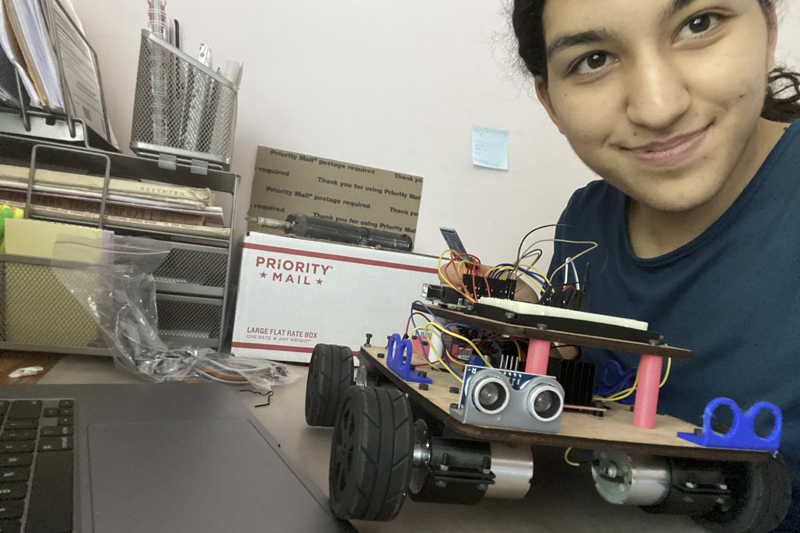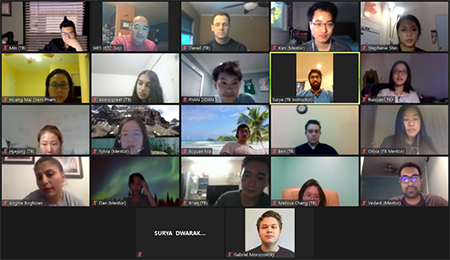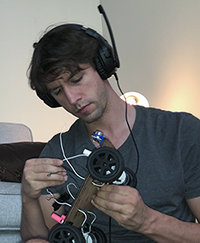Summer Program Helps Prepare Engineering Transfer Students for UCLA

Photo by Wesley Uehara
HaCK participant Shushig Lomanian with Team Sable’s car prototype.
The first year at a four-year university can be daunting, especially in the current environment of remote learning, but the Transfer Bridge to UCLA Engineering program aims to ease the transition for transfer students. Through its comprehensive and educational programming, which culminates with an annual HaCK competition, Transfer Bridge provides incoming transfer students with the opportunity to develop a strong engineering mindset and gain real-world experience.
Transfer Bridge to UCLA Engineering is a 14-week summer program for incoming engineering transfer students, eTransfers. This year, beginning June 22, participants met virtually for 10 weeks of classroom boot camp and course review. The boot camp focused on topics such as differential equations, linear algebra and computer science, with opportunities for students to take sample exams and develop strong study strategies.
The complimentary program also included a two-week eTransfer 101 orientation program and two weeks of basic training design workshops, taught by a team of undergraduate student mentors.
“The students’ decision to spend the entirety of their summer, investing in preparing themselves as Bruin Engineers is a testament to their commitment to their journey in becoming professional engineers and future leaders of our community,” said Wes Uehara, UCLA Samueli’s transfer center director, who heads the Transfer Bridge camp.
About a quarter of this year’s 200-plus incoming engineering transfer students participated in the program. The curriculum culminated with the HaCK competition, an intense technical challenge in which participants were required to utilize their newfound knowledge and skill set. HaCK provides an opportunity for transfer students to build confidence needed to succeed in the rigorous UCLA engineering program.

“As a transfer student, I worried that I missed out on many of the opportunities UCLA offers for engineering students in clubs and classes,” said Shushig Lomanian, one of this year’s participants. “The HaCK project showed me what I am capable of, and that I still have time to both learn and apply new skills.”
Transfer Bridge students attend workshops that supply them with the engineering design tools needed to take part in the HaCK competition. They are then placed in small groups, and provided with the necessary materials and details of the challenge they need to tackle. Teams are given roughly two days to design, build and test their projects before presenting them in front of a panel of judges composed of graduate students, faculty and alumni.
Despite being held remotely this year, Transfer Bridge was successful in providing incoming transfer students the tools they needed for a smooth transition.
This year’s challenge involved building a small prototype of an avoidance-tracking smart car that could successfully traverse a 1.5×1.5-meter arena autonomously and create a model of its surroundings. After attending virtual workshops taught by undergraduate mentors to learn about microcontrollers, coding languages and computer-aided design software SolidWorks, the 45 participants were split into groups of three to complete the challenge remotely.
Each participant handled a different task, with one member in charge of using the parts to build a car prototype and produce CAD models of improvements they would make based on testing, another focusing on coding to operate the vehicle and its sensors, and the third working on data collection and mapping.
The winner of this year’s HaCK was Team Sable, which included Lomanian, a mechanical engineering student from Glendale Community College; Daniel Do, an aerospace engineering student from Las Positas College in Livermore, Calif.; and Gabriel Morozowky, an electrical engineering student from Los Angeles Valley College.
“I think in the future I will not only be able to apply the programming, teamwork, communication and critical thinking skills developed during HaCK, but continue to sharpen my ability to creatively ‘think on my feet’ as was needed for the HaCK competition,” Morozowky said.
Team Sable built an autonomous smart car that could map the position of itself and surrounding objects, and communicate wirelessly via Bluetooth to a computer running a Python script written by the team. Do, Lomanian and Morozowky coded a program that helped determine where the car would go without hitting any objects, and ultimately created a data map from the vehicle.

HaCK is designed to mimic real-world situations, helping students hone their knowledge and skills, and prepare for both their UCLA classes and future career.
“In addition to helping HaCKers further develop their design tool-belt, we wanted to help participants develop a strong engineering mindset by analyzing problems that arose along the way and determining next steps while being mindful of budgeting and material constraints,” said Gabriel Alpuerto, an undergraduate student mentor of the program.
Despite being held remotely this year, Transfer Bridge was successful in providing incoming transfer students the tools they needed for a smooth transition, especially since students would begin their first quarter at UCLA in a virtual setting.
“I actually am taking some lessons learned during HaCK and applying them to two of my classes this quarter,” Morozowky said. “Both classes have assigned work-from-home team projects and I am able to take the teamwork and communication skills used in HaCK and apply them to both groups to work more efficiently.”
Beyond teaching students new skills, Transfer Bridge offers opportunities for cohort-building and networking, as well as educational and professional support throughout the academic year.
“My experience has allowed me to start off UCLA with a strong foundation by providing me with a unique experience that will allow me to apply my technical skills, both on and off campus,” Lomanian said.
Chloe Slayter contributed to this story.
